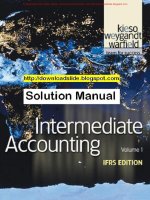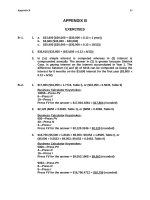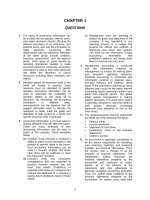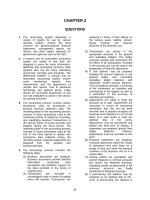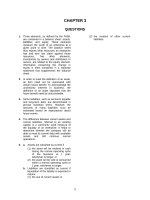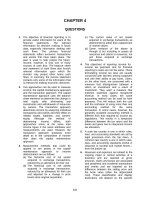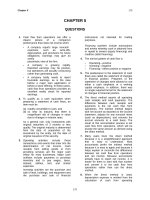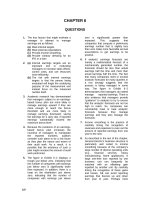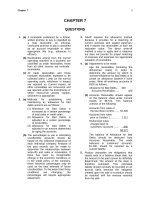Solution manual intermediate accounting 7th by nelson spiceland ch14
Bạn đang xem bản rút gọn của tài liệu. Xem và tải ngay bản đầy đủ của tài liệu tại đây (728.75 KB, 130 trang )
Find more slides, ebooks, solution manual and testbank on www.downloadslide.com
Chapter 14
Bonds and Long-Term Notes
AACSB assurance of learning standards in accounting and business education require
documentation of outcomes assessment. Although schools, departments, and faculty may approach
assessment and its documentation differently, one approach is to provide specific questions on
exams that become the basis for assessment. To aid faculty in this endeavor, we have labeled each
question, exercise, and problem in Intermediate Accounting, 7e, with the following AACSB learning
skills:
Questions
AACSB Tag
Exercises
AACSB Tag
14–1
14–2
14–3
14–4
14–5
14–6
14–7
14–8
14–9
14–10
14–11
14–12
14–13
14–14
14–15
14–16
14–17
14–18
14–19
14–20
14–21
14–22
14–23
14–24
Reflective thinking
Reflective thinking
Reflective thinking
Reflective thinking
Reflective thinking
Reflective thinking
Reflective thinking
Reflective thinking
Reflective thinking, Communications
Reflective thinking
Reflective thinking, Communications
Reflective thinking
Reflective thinking
Reflective thinking
Reflective thinking
Reflective thinking
Reflective thinking, Communications
Reflective thinking
Analytic, Communications
Reflective thinking
Reflective thinking
Reflective thinking
Analytic
Reflective thinking
14–1
14–2
14–3
14–4
14–5
14–6
14–7
14–8
14–9
14–10
14–11
14–12
14–13
14–14
14–15
14–16
14–17
14–18
14–19
14–20
14–21
14–22
14–23
14–24
14–25
14–26
14–27
14–28
14–29
14–30
14–31
14–32
14–33
14–34
Analytic
Analytic
Reflective thinking
Analytic
Analytic
Analytic
Analytic
Analytic
Analytic
Analytic
Analytic
Analytic
Analytic
Analytic
Analytic
Analytic
Analytic
Analytic
Analytic
Communications
Analytic
Analytic
Diversity
Analytic
Analytic
Analytic
Analytic
Analytic
Analytic
Analytic
Analytic
Analytic
Analytic
Communications
Brief Exercises
14–1
14–2
14–3
14–4
14–5
14–6
14–7
14–8
14–9
14–10
14–11
14–12
14–13
14–14
Analytic
Analytic
Reflective thinking
Analytic
Analytic
Analytic
Analytic
Analytic
Analytic
Analytic
Analytic
Analytic
Analytic
Reflective thinking
Solutions Manual, Vol.2, Chapter 14
CPA/CMA
1
2
3
4
Reflective thinking
Reflective thinking
Analytic
Analytic
© The McGraw-Hill Companies, Inc., 2013
14–1
Find more slides, ebooks, solution manual and testbank on www.downloadslide.com
CPA/CMA cont.
Tags
5
6
7
8
9
10
11
12
1
2
3
Reflective thinking
Analytic
Analytic
Analytic
Analytic
Analytic
Diversity
Diversity
Reflective thinking
Analytic
Reflective thinking
Problems
14–1
14–2
14–3
14–4
14–5
14–6
14–7
14–8
14–9
14–10
14–11
14–12
14–13
14–14
14–15
14–16
14–17
14–18
14–19
14–20
14–21
14–22
14–23
14–24
Analytic
Analytic
Analytic, Communications
Analytic
Analytic
Analytic
Analytic
Analytic
Analytic
Analytic
Analytic
Analytic
Analytic
Analytic
Analytic
Analytic
Analytic
Analytic
Analytic
Reflective thinking
Analytic
Analytic
Analytic
Analytic
© The McGraw-Hill Companies, Inc., 2013
14–2
Intermediate Accounting, 7e
Find more slides, ebooks, solution manual and testbank on www.downloadslide.com
QUESTIONS FOR REVIEW OF KEY TOPICS
Question 14–1
Periodic interest is calculated as the effective interest rate times the amount of the debt
outstanding during the period. This same principle applies to the flip side of the transaction, that is,
the creditor’s receivable or investment. The approach also is the same regardless of the specific
form of the debt, that is, whether in the form of notes, bonds, leases, pensions, or other debt
instruments.
Question 14–2
Long-term liabilities are appropriately reported at their present values. The present value of a
liability is the present value of its related cash flows—specifically the present value of the face
amount of the debt instrument, if any, plus the present value of stated interest payments, if any.
Both should be discounted to present value at the effective (market) rate of interest at issuance.
Question 14–3
Bonds and notes are very similar. Both typically obligate the issuing corporation to repay a
stated amount (e.g., the principal, par value, face amount, or maturity value) at a specified maturity
date. In return for the use of the money borrowed, the company also agrees to pay interest to the
lender between the issue date and maturity. The periodic interest is a stated percentage of face
amount. In concept, bonds and notes are accounted for in precisely the same way.
Normally a company will borrow cash from a bank or other financial institution by signing a
promissory note. Corporations, especially medium- and large- sized firms, often choose to borrow
cash by issuing bonds and instead of borrowing from a lending institution, it borrows from the
public. A bond issue, in effect, breaks down a large debt into manageable parts ($1,000 units),
which makes it more attractive to individual and corporate investors. Also, bonds typically have
longer maturities than notes. The most common form of corporate debt is bonds.
Question 14–4
All of the specific promises made to bondholders are described in a bond indenture. This formal
agreement will specify the bond issue’s face amount, the stated interest rate, the method of paying
interest (whether the bonds are registered bonds or coupon bonds), whether the bonds are backed by
a lien on specified assets, and whether they are subordinated to other debt. The bond indenture also
might provide for redemption through a call feature, by serial payments, through sinking fund
provisions, or by conversion. It also will specify the trustee (usually a commercial bank or other
financial institution) appointed by the issuing firm to represent the rights of the bondholders. The
bond indenture serves as a contract between the company and the bondholder(s). If the company
fails to live up to the terms of the bond indenture, the trustee may bring legal action against the
company on behalf of the bondholders.
Solutions Manual, Vol.2, Chapter 14
© The McGraw-Hill Companies, Inc., 2013
14–3
Find more slides, ebooks, solution manual and testbank on www.downloadslide.com
Answers to Questions (continued)
Question 14–5
In order for Brandon to sell its bonds that pay only 11.5% stated interest in a 12.25% market, the
bonds would have to be priced at a discount from face amount. The discount would be the amount
that causes the bond issue to be priced to yield the market rate. In other words, an investor paying
that price would earn an effective rate of return on the investment equal to the 12.25% market rate.
Question 14–6
The price will be the present value of the periodic cash interest payments (face amount times
stated rate) plus the present value of the principal payable at maturity. Both interest and principal
are discounted to present value at the market rate of interest for securities of similar risk and
maturity.
Question 14–7
In a strict sense, it’s true that zero-coupon bonds pay no interest. “Zeros” offer a return in the
form of a “deep discount” from the face amount. Still, interest accrues at the effective rate times the
outstanding balance, but no interest is paid periodically. So, interest on zero-coupon bonds is
determined and reported in precisely the same manner as on interest-paying bonds. Under the
concept of accrual accounting, the periodic effective interest is unaffected by when the cash actually
is paid. Corporations can deduct for tax purposes the annual interest expense, but without cash
outflow until the bonds mature.
Question 14–8
When bonds are issued at a premium, the debt declines each period because the effective interest
each period is less than the cash interest paid. The “overpayments” each period reduce the balance
owed. This is precisely the opposite of when debt is sold at a discount. In that case, the effective
interest each period is more than the cash paid, and the “underpayment” of interest adds to the
amount owed.
© The McGraw-Hill Companies, Inc., 2013
14–4
Intermediate Accounting, 7e
Find more slides, ebooks, solution manual and testbank on www.downloadslide.com
Answers to Questions (continued)
Question 14–9
By the effective interest method, interest expense is recorded each period as the effective
market rate of interest multiplied by the outstanding balance of the debt (during the interest period).
This simply is an application of the accrual concept, consistent with accruing all expenses as they
are incurred. The difference between the interest expense and the interest paid increases (or
decreases) the existing bond liability and is reflected as “amortization” of the discount (or premium).
An exception to the conceptually appropriate method of determining interest for bond issues is
the straight-line method. Companies are allowed to determine interest indirectly by allocating a
discount or a premium equally to each period over the term to maturity if doing so produces results
that are not materially different from the effective interest method. The firm’s decision should be
guided by whether the straight-line method would tend to mislead investors and creditors in the
particular circumstance.
The straight-line method results in a constant dollar amount of interest expense each period. By
the straight-line method, the amount of the discount to be reduced periodically is calculated, and the
effective interest is the “plug” figure. By the effective interest method, the dollar amounts of interest
vary over the term to maturity because the percentage rate of interest remains constant, but is
applied to a changing debt balance. The “straight-line method” is not an alternative method of
determining interest in a conceptual sense, but is an application of the materiality concept.
Question 14–10
The prescribed treatment requires a debit to an asset account—"debt issue costs”—which is then
allocated to expense, usually on a straight-line basis. An appealing alternative would be to reduce
the recorded amount of the debt by the debt issue costs. This approach has the appeal of reflecting
the effect debt issue costs have on the effective interest rate.
Debt issue costs reduce the net cash the company receives from the sale of the financial
instrument. A lower net amount is borrowed at the same cost, increasing the effective interest rate.
The actual increase in the effective interest rate is reflected in the interest expense if the issue cost is
allowed to reduce the premium (or increase the discount) on the debt.
This approach also is consistent with the treatment of issue costs when shares of stock are sold.
Share issue costs are recorded as a reduction in the amount credited to stock accounts (see Chapter
18).
Solutions Manual, Vol.2, Chapter 14
© The McGraw-Hill Companies, Inc., 2013
14–5
Find more slides, ebooks, solution manual and testbank on www.downloadslide.com
Answers to Questions (continued)
Question 14–11
When the stated interest rate is not indicative of the market rate at the time a note is negotiated,
the value of the asset (cash or noncash) or service exchanged for the note establishes the market rate.
This rate is the implicit rate of interest.
If the value of the asset (or service) is not readily determinable, the implicit rate may not be
apparent. In that case an appropriate rate should be “imputed” as the rate that would be expected in
a similar transaction, under similar circumstances.
The economic essence of a transaction should prevail over its outward appearance. The
accountant should look beyond the form of this transaction and record its substance. The amount
actually paid for the asset is the present value of the cash flows called for by the loan agreement,
discounted at the “imputed” market rate. Both the asset acquired and the liability used to purchase it
should be recorded at the real cost.
Question 14–12
Mandatorily redeemable shares, which the issuing company is obligated to buy back in exchange
for cash or other assets, must be reported as liabilities.
Question 14–13
When notes are paid in installments, rather than a single amount at maturity, installment
payments typically are equal amounts each period. Each payment will include both an amount
representing interest and an amount representing a reduction of principal. At maturity, the principal
is completely paid. The installment amount is calculated by dividing the amount of the loan by the
appropriate discount factor for the present value of an annuity.
Determining periodic interest is the same as for a note whose principal is paid at maturity—
effective interest rate times the outstanding principal. But the periodic cash payments are larger and
there is no lump-sum payment at maturity.
Question 14–14
For all long-term borrowings, disclosure should include (a) the fair values, (b) the aggregate
amounts maturing, and (c) sinking fund requirements (if any) for each of the next five years.
Question 14–15
Regardless of the method used to retire debt prior to its scheduled maturity date, the gain or loss
on the transaction is simply the difference between the carrying amount of the debt at that time and
the cash paid to retire it. To record the extinguishment, the account balances pertinent to the debt
are removed from the books. Cash is credited for the amount paid (the call price or market price).
The difference between the carrying amount and the reacquisition price is the gain or loss.
Question 14–16
Gains and losses are reported as extraordinary items when they are considered to be material
and both unusual and infrequent. In that case, they are reported separate from ordinary operations
and net of their tax effects.
© The McGraw-Hill Companies, Inc., 2013
14–6
Intermediate Accounting, 7e
Find more slides, ebooks, solution manual and testbank on www.downloadslide.com
Answers to Questions (continued)
Question 14–17
GAAP requires that the entire issue price of convertible bonds be recorded as debt, precisely the
same way, in fact, as for nonconvertible bonds. On the other hand, the issue price of bonds with
detachable warrants is allocated between the two different securities on the basis of their market
values.
The difference is based on the relative separability of the debt and equity features of the two
securities. In the case of convertible bonds, the two features of the security, the debt and the
conversion option, are physically inseparable—the option cannot be exercised without surrendering
the debt. But the debt and equity features of bonds with detachable warrants can be separated.
Unlike a conversion feature, warrants can be separated from the bonds and can be exercised
independently or traded in the market separately from bonds. In substance, two different
securities—the bonds and the warrants—are sold as a "package" for a single issue price.
Question 14–18
Additional consideration a company provides to induce conversion of convertible debt should be
recorded as an expense of the period. It is measured at the fair value of that consideration. This
might be cash paid, the market price of stock warrants given, or the market value of additional
shares issued due to modifying the conversion ratio.
Question 14–19
Rising interest rates, other factors remaining the same, cause prices of fixed-rate securities to
fall. For the investor in these securities, the price decline represents a loss; but for Cordova Tools,
the debtor, the decline in the value of the liability is a gain. If Cordova has elected the fair value
option for the bonds, it will report the gain on change in the fair value of the bonds in its income
statement.
Question 14–20
Under International Financial Reporting Standards, unlike U.S. GAAP, convertible debt is
divided into its liability and equity elements. If a company prepares its financial statements
according to IFRS, it accounts for convertible bonds it issues for $12.5 million by separating the
$12.5 million into two parts. Effectively, the company is selling two securities—(1) bonds and (2)
an option to convert to stock—for one package price. The bonds represent a liability; the option is
shareholders’ equity. It would record the fair value of the bonds as the liability and the remaining
difference between the fair value of the convertible bonds, $12.5 million, and the fair value of the
bonds as equity. If the fair value of the bonds cannot be determined from an active trading market,
that value can be calculated as the present value of the bonds’ cash flows, using the market rate of
interest
Question 14–21
All bonds sell at their price plus any interest that has accrued since the last interest date to
simplify the process of paying and recording interest. The buyer is asked to pay the seller accrued
interest for any time that has elapsed since the last interest date in addition to the price of the bonds
so that when a full six months’ interest is paid at the next interest date, the net interest paid/received
will be correct for the time the bonds have been held by the investor.
Solutions Manual, Vol.2, Chapter 14
© The McGraw-Hill Companies, Inc., 2013
14–7
Find more slides, ebooks, solution manual and testbank on www.downloadslide.com
Answers to Questions (concluded)
Question 14–22
By definition, a troubled debt restructuring involves some concessions on the part of the creditor
(lender). A creditor may feel it can minimize losses by restructuring a debt agreement, rather than
forcing liquidation. A troubled debt restructuring takes one of two forms, with the second further
categorized for accounting purposes:
1. The debt may be settled at the time of the restructuring, or
2. The debt may be continued, but with modified terms.
a. Under the modified terms, total cash to be paid is less than the carrying amount of the debt.
b. Under the modified terms, total cash to be paid exceeds the carrying amount of the debt.
Question 14–23
Pratt has a gain of $2 million (the difference between the carrying amount of the debt and the
fair value of the property transferred). Pratt also must adjust the carrying amount of the land to its
fair value prior to recording its exchange for the debt. Pratt would need to change the recorded
amount for the property specified in the exchange agreement from $2 million to the $3 million fair
value. This produces a “gain on disposition of assets” of $1 million. So, Pratt would report two
items on its income statement in connection with the troubled debt restructuring: (1) a $2 million
gain on troubled debt restructuring and (2) a “gain on disposition of assets” of $1 million.
Question 14–24
(a) When the total future cash payments are less than the carrying amount of the debt, the difference
is recorded as a gain to the debtor at the date of restructure. No interest is recorded thereafter.
All subsequent cash payments produce reductions of principal.
(b) When the total future cash payments exceed the carrying amount of the debt, no reduction of the
existing debt is necessary and no entry is required at the time of the debt restructuring. The
accounting objective is to determine the new (lower) effective interest and to record interest
expense for the remaining term of the loan at that new, lower rate.
© The McGraw-Hill Companies, Inc., 2013
14–8
Intermediate Accounting, 7e
Find more slides, ebooks, solution manual and testbank on www.downloadslide.com
BRIEF EXERCISES
Brief Exercise 14–1
$30,000,000 x
face
amount
6%
annual
rate
x
6/12
=
fraction of the
annual period
$900,000
cash
interest
Brief Exercise 14–2
Interest
$ 2,000,000 ¥
Principal
$80,000,000
Present value (price) of the bonds
x
x
23.11477*
0.30656**
=
=
$46,229,540
24,524,800
$70,754,340
¥ [5 ÷ 2] % x $80,000,000
* Present value of an ordinary annuity of $1: n = 40, i = 3%. (Table 4)
** Present value of $1: n = 40, i = 3%. (Table 2)
Brief Exercise 14–3
The price will be the present value of the periodic cash interest payments (face
amount times stated rate) plus the present value of the principal payable at maturity.
Both interest and principal are discounted to present value at the market rate of
interest for securities of similar risk and maturity. When the stated rate and the market
rate are the same, the bonds will sell at face value, $75 million in this instance.
Brief Exercise 14–4
Interest
$ 2,500,000 ¥
Principal
$100,000,000
Present value (price) of the bonds
x
x
27.35548*
0.45289**
=
=
$ 68,388,700
45,289,000
$113,677,700
¥ [5 ÷ 2] % x $100,000,000
* Present value of an ordinary annuity of $1: n = 40, i = 2%. (Table 4)
** Present value of $1: n = 40, i = 2%. (Table 2)
Solutions Manual, Vol.2, Chapter 14
© The McGraw-Hill Companies, Inc., 2013
14–9
Find more slides, ebooks, solution manual and testbank on www.downloadslide.com
Brief Exercise 14–5
Interest will be the effective rate times the outstanding balance:
4% x $82,218,585 = $3,288,743
Brief Exercise 14–6
Interest will be the effective rate times the outstanding balance:
June 30
Interest expense (2% x $69,033,776) ................................
Discount on bonds payable (difference) .................
Cash (1.5% x $80,000,000) .......................................
December 31
Interest expense (2% x [$69,033,776 + 180,676]) ..........
Discount on bonds payable (difference) .................
Cash (1.5% x $80,000,000) .......................................
1,380,676
180,676
1,200,000
1,384,289
184,289
1,200,000
Interest expense for the year: $1,380,676 + 1,384,289 = $2,764,965
Brief Exercise 14–7
Interest will be a plug figure:
$80,000,000 – 69,033,776 = $10,966,224 discount
$10,966,224 ÷ 40 semiannual periods = $274,156 reduction each period
June 30
Interest expense (to balance) .............................................
Discount on bonds payable (difference) .................
Cash (1.5% x $80,000,000) .......................................
December 31
Interest expense (to balance) .............................................
Discount on bonds payable (difference) .................
Cash (1.5% x $80,000,000) .......................................
1,474,156
274,156
1,200,000
1,474,156
274,156
1,200,000
Interest expense for the year: $1,474,156 + 1,474,156 = $2,948,312
© The McGraw-Hill Companies, Inc., 2013
14–10
Intermediate Accounting, 7e
Find more slides, ebooks, solution manual and testbank on www.downloadslide.com
Brief Exercise 14–8
Interest will be the effective rate times the outstanding balance:
June 30
Cash (1.5% x $80,000,000) ..........................................
Discount on investment in bonds (difference) ...........
Interest revenue (2% x $69,033,776) ............................
1,200,000
180,676
December 31
Cash (1.5% x $80,000,000) ..........................................
Discount on investment in bonds (difference) ...........
Interest revenue (2% x [$69,033,776 + 180,676]) ......
1,200,000
184,289
1,380,676
1,384,289
Brief Exercise 14–9
Interest
$6,000¥ x 2.72325 *
Principal
$300,000 x 0.86384 **
Present value (price) of the note
=
=
$ 16,340
259,152
$275,492
¥ 2% x $300,000
* Present value of an ordinary annuity of $1: n = 3, i = 5%. (Table 4)
** Present value of $1: n = 3, i = 5%. (Table 2)
Equipment (price determined above) ................................
Discount on notes payable (difference) .........................
Notes payable (face amount) ......................................
Solutions Manual, Vol.2, Chapter 14
275,492
24,508
300,000
© The McGraw-Hill Companies, Inc., 2013
14–11
Find more slides, ebooks, solution manual and testbank on www.downloadslide.com
Brief Exercise 14–10
$300,000 ÷ 2.72325 =
amount
of loan
(from Table 4)
n = 3, i = 5%
$110,162
installment
payment
Helpful, but not required:
Cash
Payment
1
2
3
110,162
110,162
110,162
Effective
Interest
5% x Outstanding Balance
.05 (300,000) =
.05 (204,838) =
.05 (104,918) =
15,000
10,242
5,246
Decrease in
Balance
Balance Reduction
95,162
99,920
104,918*
Outstanding
Balance
300,000
204,838
104,918
0
* rounded
Interest expense (5% x ($300,000 – [$110,162 – 5% x $300,000]))
Note payable (difference) ...............................................
Cash (payment determined above) .................................
10,242
99,920
110,162
Brief Exercise 14–11
($ in millions)
Bonds payable (face amount) ......................................
Loss on early extinguishment (to balance) .................
Discount on bonds (given) .....................................
Cash ($60,000,000 x 102%) ......................................
© The McGraw-Hill Companies, Inc., 2013
14–12
60.0
3.2
2.0
61.2
Intermediate Accounting, 7e
Find more slides, ebooks, solution manual and testbank on www.downloadslide.com
Brief Exercise 14–12
The issue price of bonds with detachable warrants is allocated between the two
different securities on the basis of their market values.
($ in millions)
Cash (102% x $60 million)......................................................
Discount on bonds payable (difference) ...............................
Bonds payable (face amount) .............................................
Equity—stock warrants outstanding
($5 x 10 warrants x 60,000 bonds) ......................................
61.2
1.8
60.0
3.0
Brief Exercise 14–13
GAAP requires that the entire issue price of convertible bonds be recorded as
debt, precisely the same way, in fact, as for nonconvertible bonds.
($ in millions)
Cash (102% x $60 million)......................................................
Premium on bonds payable (difference)............................
Bonds payable (face amount) .............................................
61.2
1.2
60.0
Brief Exercise 14–14
AI will report a gain when adjusting the bonds to fair value. A decrease in the fair
value of a liability is a gain, just the opposite of a decrease in the value of an asset.
If the change in fair value is attributable to a change in the interest rate, the rate
increased. This is because as interest rates rise, the value of a fixed rate instrument—
like bonds—falls, as occurred with AI’s bonds.
Solutions Manual, Vol.2, Chapter 14
© The McGraw-Hill Companies, Inc., 2013
14–13
Find more slides, ebooks, solution manual and testbank on www.downloadslide.com
EXERCISES
Exercise 14–1
The DD Corp. bonds are appropriately priced to yield the market rate of interest.
The GG Corp. bonds are slightly underpriced at the stated price and, therefore, are the
most attractive. The BB Corp. bonds are slightly overpriced and are the least
attractive. Bonds are priced to yield the market rate, 10% in this case. When this rate
is used to price the bonds, we get the prices shown below. Presumably, the market
rate changed since the underwriters priced two of the bond issues.
BB Corp. bonds:
Interest
$ 5,500,000 ¥
Principal
$100,000,000
Present value (price) of the bonds
x
x
17.15909 *
0.14205 **
=
=
$ 94,374,995
14,205,000
$108,579,995
¥ [11 ÷2 ] % x $100,000,000
* Present value of an ordinary annuity of $1: n = 40, i = 5 % (Table 4)
** Present value of $1: n = 40, i = 5% (Table 2)
DD Corp. bonds:
Interest
$ 5,000,000 ¥
Principal
$100,000,000
Present value (price) of the bonds
x
x
17.15909 *
0.14205 **
=
=
$ 85,795,450
14,205,000
$100,000,450
Note: The result differs from $100,000,000 only because the present value factors in any
present value table are rounded. Because the stated rate and the market rate are the
same, the true present value is $100,000,000.
¥ [10 ÷ 2] % x $100,000,000
* Present value of an ordinary annuity of $1: n = 40, i = 5% (Table 4)
** Present value of $1: n = 40, i = 5% (Table 2)
GG Corp. bonds:
Interest
$ 4,500,000 ¥
Principal
$100,000,000
Present value (price) of the bonds
x
x
17.15909 *
0.14205 **
=
=
$77,215,905
14,205,000
$91,420,905
¥ [ 9÷ 2] % x $100,000,000
* Present value of an ordinary annuity of $1: n = 40, i = 5% (Table 4)
** present value of $1: n = 40, i = 5% (Table 2)
© The McGraw-Hill Companies, Inc., 2013
14–14
Intermediate Accounting, 7e
Find more slides, ebooks, solution manual and testbank on www.downloadslide.com
Exercise 14–2
1. Maturity
10 years
Interest paid
annually
$100,000 ¥
Stated rate
10%
Interest
x
Principal
$1,000,000
x
Present value (price) of the bonds
Effective (market) rate
12%
*
5.65022 =
$565,022
321,970
0.32197 ** =
$886,992
¥ 10% x $1,000,000
* Present value of an ordinary annuity of $1: n = 10, i = 12% (Table 4)
** Present value of $1: n = 10, i = 12% (Table 2)
2. Maturity
Interest paid
Stated rate
Effective (market) rate
10 years
semiannually
10%
12%
Interest
$50,000 ¥
x
11.46992 * =
$573,496
**
=
311,800
Principal
$1,000,000
x
0.31180
Present value (price) of the bonds
$885,296
¥ 5% x $1,000,000
* Present value of an ordinary annuity of $1: n = 20, i = 6% (Table 4)
** Present value of $1: n = 20, i = 6% (Table 2)
3. Maturity
10 years
Interest paid
semiannually
$60,000 ¥
Stated rate
12%
Interest
x
Principal
$1,000,000
x
Present value (price) of the bonds
Effective (market) rate
10%
*
12.46221 = $ 747,733
376,890
0.37689 ** =
$1,124,623
¥ 6% x $1,000,000
* Present value of an ordinary annuity of $1: n = 20, i = 5% (Table 4)
** Present value of $1: n = 20, i = 5% (Table 2)
4. Maturity
20 years
Interest paid
semiannually
$60,000 ¥
Stated rate
12%
Interest
x
Principal
$1,000,000
x
Present value (price) of the bonds
Effective (market) rate
10%
17.15909 * = $1,029,545
142,050
0.14205 ** =
$1,171,595
¥ 6% x $1,000,000
* Present value of an ordinary annuity of $1: n = 40, i = 5% (Table 4)
** Present value of $1: n = 40, i = 5% (Table 2)
Solutions Manual, Vol.2, Chapter 14
© The McGraw-Hill Companies, Inc., 2013
14–15
Find more slides, ebooks, solution manual and testbank on www.downloadslide.com
Exercise 14–2 (concluded)
5. Maturity
20 years
Interest paid
semiannually
$60,000 ¥
Stated rate
12%
Interest
x
Principal
$1,000,000
x
Present value (price) of the bonds
Effective (market) rate
12%
*
15.04630 = $902,778
97,220
0.09722 ** =
$999,998
actually, $1,000,000 if PV table factors were not rounded
¥ 6% x $1,000,000
* Present value of an ordinary annuity of $1: n = 40, i = 6% (Table 4)
** Present value of $1: n = 40, i = 6% (Table 2)
© The McGraw-Hill Companies, Inc., 2013
14–16
Intermediate Accounting, 7e
Find more slides, ebooks, solution manual and testbank on www.downloadslide.com
Exercise 14–3
1. Price of the bonds at January 1, 2013
x
Interest
$4,000,000¥
Principal
$80,000,000
x
Present value (price) of the bonds
11.46992 *
0.31180 **
=
=
$45,879,680
24,944,000
$70,823,680
¥ 5% x $80,000,000
* Present value of an ordinary annuity of $1: n = 20, i = 6% (Table 4)
** Present value of $1: n = 20, i = 6% (Table 2)
2. January 1, 2013
Cash (price determined above) ...................................... 70,823,680
Discount on bonds (difference) .................................. 9,176,320
80,000,000
Bonds payable (face amount)..................................
3. June 30, 2013
Interest expense (6% x $70,823,680) ................................
Discount on bonds payable (difference).................
Cash (5% x $80,000,000) .........................................
4,249,421
249,421
4,000,000
Partial amortization schedule (not required)
Cash
Payment
5% x Face Amount
1 4,000,000
2 4,000,000
Effective
Interest
6% x Outstanding Balance
.06 (70,823,680) = 4,249,421
.06 (71,073,101) = 4,264,386
Increase in
Outstanding
Balance
Balance
Discount Reduction
249,421
264,386
70,823,680
71,073,101
71,337,487
4. December 31, 2013
Interest expense (6% x [$70,823,680 + 249,421]) ............
Discount on bonds payable (difference).................
Cash (5% x $80,000,000) .........................................
Solutions Manual, Vol.2, Chapter 14
4,264,386
264,386
4,000,000
© The McGraw-Hill Companies, Inc., 2013
14–17
Find more slides, ebooks, solution manual and testbank on www.downloadslide.com
Exercise 14–4
1. January 1, 2013
Interest $4,000,000¥ x 11.46992 *
Principal $80,000,000 x 0.31180 **
Present value (price) of the bonds
=
=
$45,879,680
24,944,000
$70,823,680
¥ 5% x $80,000,000
* Present value of an ordinary annuity of $1: n = 20, i = 6% (Table 4)
** Present value of $1: n = 20, i = 6% (Table 2)
Bond investment (face amount) .................................. 80,000,000
9,176,320
Discount on bond investment (difference)..............
70,823,680
Cash (price determined above) ..................................
2. June 30, 2013
Cash (5% x $80,000,000) .............................................
Discount on bond investment (difference).....................
Interest revenue (6% x $70,823,680) ............................
4,000,000
249,421
4,249,421
3. December 31, 2013
Cash (5% x $80,000,000) .............................................
Discount on bond investment (difference) .................
Interest revenue (6% x [$70,823,680 + 249,421]) ........
© The McGraw-Hill Companies, Inc., 2013
14–18
4,000,000
264,386
4,264,386
Intermediate Accounting, 7e
Find more slides, ebooks, solution manual and testbank on www.downloadslide.com
Exercise 14–5
1. Liability at December 31, 2013
Bonds payable (face amount) .....................................
Less: discount ..........................................................
Initial balance, January 1, 2013 ...............................
June 30, 2013 discount amortization .......................
Dec. 31, 2013 discount amortization .......................
December 31, 2013 net liability ..............................
$320,000,000
36,705,280
$283,294,720
997,683*
1,057,544**
$285,349,947
2. Interest expense for year ended December 31, 2013
June 30, 2013 interest expense ................................
Dec. 31, 2013 interest expense ................................
Interest expense for 2013.........................................
$16,997,683*
17,057,544**
$34,055,227
3. Statement of cash flows for year ended December 31, 2013
Myriad would report the cash inflow of $283,294,720*** from the sale of the
bonds as a cash inflow from financing activities in its statement of cash flows.
The $32,000,000 ($16,000,000* + 16,000,000**) cash interest paid is cash
outflow from operating activities because interest is an income statement
(operating) item.
Solutions Manual, Vol.2, Chapter 14
© The McGraw-Hill Companies, Inc., 2013
14–19
Find more slides, ebooks, solution manual and testbank on www.downloadslide.com
Exercise 14–5 (concluded)
Calculations:
January 1, 2013***
Cash (price given) ....................................................... 283,294,720
Discount on bonds (difference) .................................. 36,705,280
320,000,000
Bonds payable (face amount) ..................................
June 30, 2013*
Interest expense (6% x $283,294,720) .............................. 16,997,683
997,683
Discount on bonds payable (difference) .................
16,000,000
Cash (5% x $320,000,000) ........................................
December 31, 2013**
Interest expense (6% x [$283,294,720 + 997,683]) .......... 17,057,544
1,057,544
Discount on bonds payable (difference) .................
16,000,000
Cash (5% x $320,000,000) ........................................
© The McGraw-Hill Companies, Inc., 2013
14–20
Intermediate Accounting, 7e
Find more slides, ebooks, solution manual and testbank on www.downloadslide.com
Exercise 14–6
1. June 30, 2013
Cash (price given) .......................................................
Bonds payable (face amount)..................................
Premium on bonds payable (difference) ................
967,707
900,000
67,707
2. December 31, 2013
Interest expense (6% x $967,707) .....................................
Premium on bonds payable (difference) ....................
Cash (6.5% x $900,000) ...........................................
58,062
438
58,500
3. June 30, 2014
Interest expense (6% x [$967,707 – 438]) .........................
Premium on bonds payable (difference) ....................
Cash (6.5% x $900,000) ...........................................
Solutions Manual, Vol.2, Chapter 14
58,036
464
58,500
© The McGraw-Hill Companies, Inc., 2013
14–21
Find more slides, ebooks, solution manual and testbank on www.downloadslide.com
Exercise 14–7
1. Price of the bonds at January 1, 2013
Interest
$7,500,000¥ x 13.76483 *
Principal
$150,000,000 x 0.17411 **
Present value (price) of the bonds
=
=
$103,236,225
26,116,500
$129,352,725
¥ 5% x $150,000,000
* Present value of an ordinary annuity of $1: n = 30, i = 6% (Table 4)
** Present value of $1: n = 30, i = 6% (Table 2)
2. January 1, 2013
Cash (price determined above) ...............................
Discount on bonds payable (difference) ..............
Bonds payable (face amount) ...........................
129,352,725
20,647,275
150,000,000
3. June 30, 2013
Interest expense ($7,500,000 + 688,243) ..........................
Discount on bonds payable ($20,647,275 ÷ 30) ........
Cash (5% x $150,000,000) ........................................
8,188,243
688,243
7,500,000
4. December 31, 2020
Interest expense ($7,500,000 + 688,243) ..........................
Discount on bonds payable ($20,647,275 ÷ 30) ........
Cash (5% x $150,000,000) ........................................
8,188,243
688,243
7,500,000
[Using the straight-line method, each interest entry is the same.]
© The McGraw-Hill Companies, Inc., 2013
14–22
Intermediate Accounting, 7e
Find more slides, ebooks, solution manual and testbank on www.downloadslide.com
Exercise 14–8
1. January 1, 2013
Interest
$7,500,000¥ x 13.76483 *
Principal $150,000,000 x 0.17411 **
Present value (price) of the bonds
=
=
$103,236,225
26,116,500
$129,352,725
¥ 5% x $150,000,000
* Present value of an ordinary annuity of $1: n = 30, i = 6% (Table 4)
** Present value of $1: n = 30, i = 6% (Table 2)
Bond investment (face amount) ..............................
Discount on bond investment (difference) .........
Cash (price determined above) ..............................
150,000,000
20,647,275
129,352,725
2. June 30, 2013
Cash (5% x $150,000,000) ...........................................
Discount on bond investment ($20,647,275 ÷ 30).........
Interest revenue ($7,500,000 + 688,243) ......................
7,500,000
688,243
8,188,243
3. December 31, 2020
Cash (5% x $150,000,000) ...........................................
Discount on bond investment ($20,647,275 ÷ 30).........
Interest revenue ($7,500,000 + 688,243) ......................
7,500,000
688,243
8,188,243
[Using the straight-line method, each interest entry is the same.]
Solutions Manual, Vol.2, Chapter 14
© The McGraw-Hill Companies, Inc., 2013
14–23
Find more slides, ebooks, solution manual and testbank on www.downloadslide.com
Exercise 14–9
1. Price of the bonds at January 1, 2013
Interest
$18,000¥ x 6.87396 *
Principal
$600,000 x 0.75941 **
Present value (price) of the bonds
=
=
$123,731
455,646
$579,377
¥ 3% x $600,000
* Present value of an ordinary annuity of $1: n = 8, i = 3.5% (Table 4)
** Present value of $1: n = 8, i = 3.5% (Table 2)
2. January 1, 2013
Cash (price determined above) ..........................
Discount on bonds (difference) ......................
Bonds payable (face amount) ......................
579,377
20,623
600,000
3. Amortization schedule
Cash
Payment
3% x Face Amount
1
2
3
4
5
6
7
8
18,000
18,000
18,000
18,000
18,000
18,000
18,000
18,000
.035
.035
.035
.035
.035
.035
.035
.035
Effective
Increase in
Outstanding
Interest
Balance
Balance
3.5% x Outstanding Balance Discount Reduction
(579,377)
(581,655)
(584,013)
(586,453)
(588,979)
(591,593)
(594,299)
(597,099)
144,000
*rounded
© The McGraw-Hill Companies, Inc., 2013
14–24
=
=
=
=
=
=
=
=
20,278
20,358
20,440
20,526
20,614
20,706
20,800
20,901*
2,278
2,358
2,440
2,526
2,614
2,706
2,800
2,901
164,623
20,623
579,377
581,655
584,013
586,453
588,979
591,593
594,299
597,099
600,000
Intermediate Accounting, 7e
Find more slides, ebooks, solution manual and testbank on www.downloadslide.com
Exercise 14–9 (concluded)
4. June 30, 2013
Interest expense (3.5% x $579,377) ....................
Discount on bonds payable (difference)......
Cash (3% x $600,000) ..................................
December 31, 2013**
Interest expense (3.5% x [$579,377 + 2,278]) ....
Discount on bonds payable (difference)......
Cash (3% x $600,000) ..................................
20,278
2,278
18,000
20,358
2,358
18,000
5. Liability at December 31, 2013
Bonds payable (face amount) .....................................
Less: discount ..........................................................
Initial balance, January 1, 2013 ...............................
June 30, 2013 discount amortization ....................
Dec. 31, 2013 discount amortization ....................
December 31, 2013 net liability ..............................
$600,000
(20,623)
$579,377
2,278
2,358
$584,013
6. Interest expense for year ended December 31, 2013
June 30, 2013 interest expense ................................
Dec. 31, 2013 interest expense ................................
Interest expense for 2013.........................................
7. December 31, 2016
Interest expense (3.5% x $597,099) ....................
Discount on bonds payable (difference)......
Cash (3% x $600,000) ..................................
$20,278
20,358
$40,636
20,901*
2,901
18,000
* rounded value from amortization schedule
Bonds payable .....................................................
Cash ..........................................................
Solutions Manual, Vol.2, Chapter 14
600,000
600,000
© The McGraw-Hill Companies, Inc., 2013
14–25
